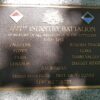The 2/27th Infantry Battalion was raised on 7th May 1940 in Woodside, South Australia and was the the second largely South Australian Battalions raised for World War II. The inscription features the symbol of the Australian Military Forces as well as the Brown and Blue patch of the division. Whilst these colours are the same as the inital 27th Infantry Battalion from World War II, the Army in World War II decided to keep the same system of the preceding battalions as well as incorporating a grey backing to distinguish the difference between units. Notable campaigns of the Battalion include the Syrian campaign, the Battle of Damour, the Kokoda Trail, and the Ramu Valley – Finisterres Operations.
The memorial inscription reads:
IN MEMORY OF ALL WHO SERVED IN THE UNIT
1940 – 1945
PALESTINE
EGPYT
SYRIA
LEBANON
KOKODA TRACK
GONA
RAMU VALLEY
SHAGGY RIDGE
BALIKPAPANLEST WE FORGET
History
Following the raising of the Battalion in Woodside in May 1940, they left for Melbourne where they were shipped out overseas on the 21st October. After a stop in India and Egypt, the battalion was sent to Palestine where they began their training.
During World War II, the Battalion was par of the 21st Brigade of the 7th Australian Division. Its assignment was to primarily bolster the defenses in the Egypt-Libya frontier in anticipation of a potential German attack. Between April and May 1941, the Brigade occupied Maaten Bagush and Matruh west of Alexandria. Upon being sent back to Palestine, it was given the offensive task of invading Syria and Lebanon beginning from the 8th June.
The 2/27th was given operations along the Lebanon coast and performed outflanking manouvers in the hills nearby the coastal plains. In January 1942, the battalion returned to Adelaide briefly before being deployed to Port Moseby in Papua New Guinea to face Japanese forces. Upon reaching Mission Ridge on the Kokoda Trail, the advance of the Japanese army caused the battalion to pull out from its position after two days. It took two weeks to withdraw through the jungle with little food and sick soldiers. The 2/27th finally re-joined the Australian force at Jawarere on the 22 September and returned to action after rest and retraining. On 28 November 1942, the battalion was sent to Gona where they faced heavy casualties from rushed and ill-prepared attacks as well as tropical disease within the Battalion.
In January 1943, the 2/27th was relieved and returned to Australia before being re-deployed to Papua again in early August. There, the battalion was part of the advance along the Ramu Valley and aided the advance into the Finisterre Ranges. Occuping several key features, the 2/27th faced one of the largest parts of the Japanese counterattack on the 12th October before being given primarily patrol based operations shortly after. In March the following year, the Battalion returned to Australia once again before being sent out for its last operation of the war in June 1945. The unit was placed at Balikpapan and formed part of the invading force that secured both the town and port between 1 – 21 July 1945.
For the final months of the war, the Battalion took part in small-scale patrolling. The 2/27th stayed within the region after the amistace and became part of the occupation force in the Celebes between mid October 1945 to January 1946. The battalion arrived in Brisbane on the 14th February before being disbanded on the 18th March.





Comments